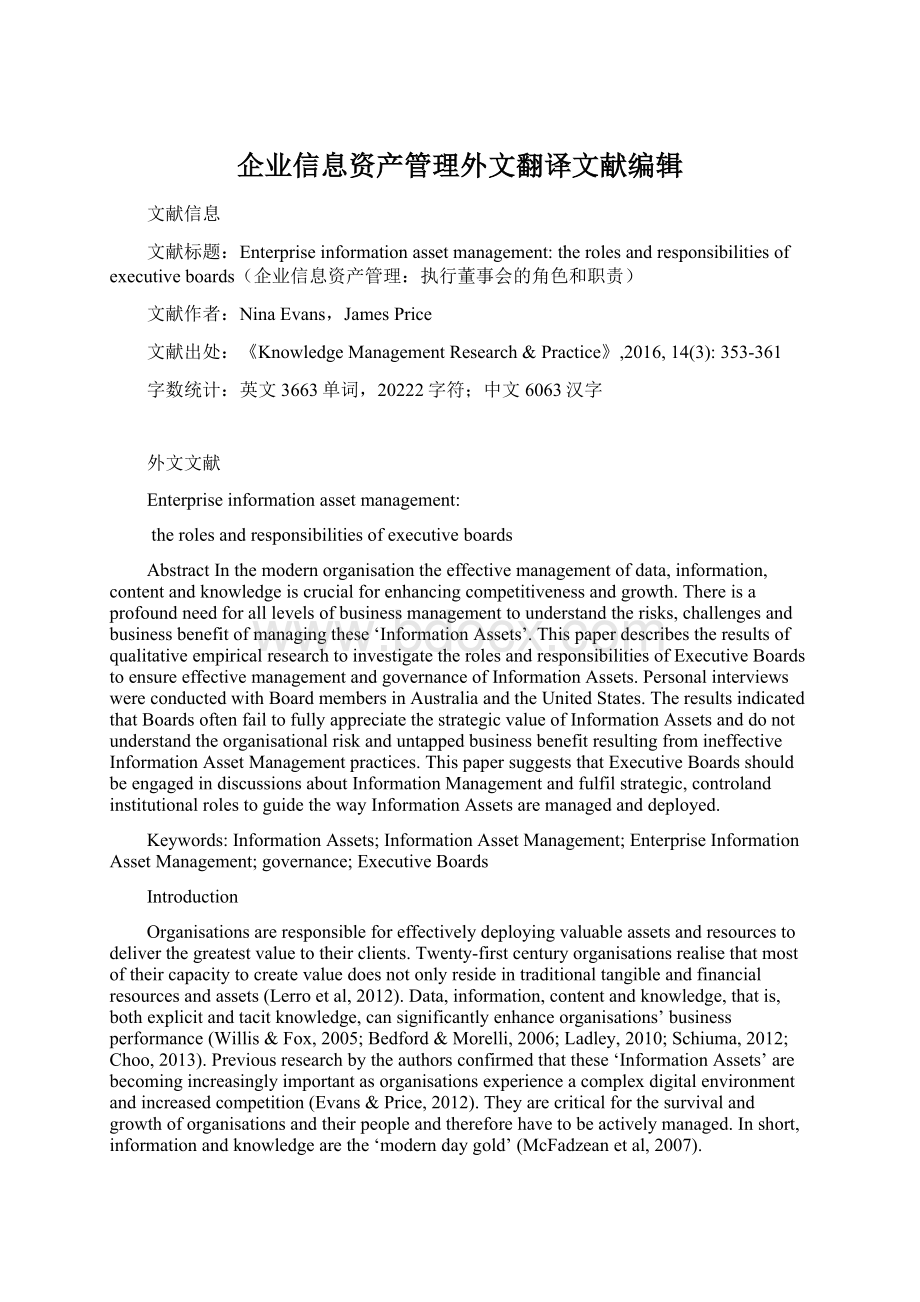企业信息资产管理外文翻译文献编辑.docx
《企业信息资产管理外文翻译文献编辑.docx》由会员分享,可在线阅读,更多相关《企业信息资产管理外文翻译文献编辑.docx(12页珍藏版)》请在冰豆网上搜索。

企业信息资产管理外文翻译文献编辑
文献信息
文献标题:
Enterpriseinformationassetmanagement:
therolesandresponsibilitiesofexecutiveboards(企业信息资产管理:
执行董事会的角色和职责)
文献作者:
NinaEvans,JamesPrice
文献出处:
《KnowledgeManagementResearch&Practice》,2016,14(3):
353-361
字数统计:
英文3663单词,20222字符;中文6063汉字
外文文献
Enterpriseinformationassetmanagement:
therolesandresponsibilitiesofexecutiveboards
AbstractInthemodernorganisationtheeffectivemanagementofdata,information,contentandknowledgeiscrucialforenhancingcompetitivenessandgrowth.Thereisaprofoundneedforalllevelsofbusinessmanagementtounderstandtherisks,challengesandbusinessbenefitofmanagingthese‘InformationAssets’.ThispaperdescribestheresultsofqualitativeempiricalresearchtoinvestigatetherolesandresponsibilitiesofExecutiveBoardstoensureeffectivemanagementandgovernanceofInformationAssets.PersonalinterviewswereconductedwithBoardmembersinAustraliaandtheUnitedStates.TheresultsindicatedthatBoardsoftenfailtofullyappreciatethestrategicvalueofInformationAssetsanddonotunderstandtheorganisationalriskanduntappedbusinessbenefitresultingfromineffectiveInformationAssetManagementpractices.ThispapersuggeststhatExecutiveBoardsshouldbeengagedindiscussionsaboutInformationManagementandfulfilstrategic,controlandinstitutionalrolestoguidethewayInformationAssetsaremanagedanddeployed.
Keywords:
InformationAssets;InformationAssetManagement;EnterpriseInformationAssetManagement;governance;ExecutiveBoards
Introduction
Organisationsareresponsibleforeffectivelydeployingvaluableassetsandresourcestodeliverthegreatestvaluetotheirclients.Twenty-firstcenturyorganisationsrealisethatmostoftheircapacitytocreatevaluedoesnotonlyresideintraditionaltangibleandfinancialresourcesandassets(Lerroetal,2012).Data,information,contentandknowledge,thatis,bothexplicitandtacitknowledge,cansignificantlyenhanceorganisations’businessperformance(Willis&Fox,2005;Bedford&Morelli,2006;Ladley,2010;Schiuma,2012;Choo,2013).Previousresearchbytheauthorsconfirmedthatthese‘InformationAssets’arebecomingincreasinglyimportantasorganisationsexperienceacomplexdigitalenvironmentandincreasedcompetition(Evans&Price,2012).Theyarecriticalforthesurvivalandgrowthoforganisationsandtheirpeopleandthereforehavetobeactivelymanaged.Inshort,informationandknowledgearethe‘moderndaygold’(McFadzeanetal,2007).
Varioustermsanddefinitionscanbeemployedtodescribeintangibleinformationandknowledge.ForthepurposeofthispaperthetermInformationAssetsisusedtorefertoallexplicit,codifieddata,documentsandpublishedcontent,irrespectiveofmedium(hardcopyorsoftcopy)andformat(e.g.,Worddocument,spreadsheet,email,drawingandHTML).Thedefinitionalsoincludestacitknowledge,thatis,knowledgeinpeoples’head.
Theseintangibleassetsareinputstothebusiness.InformationAssetManagement(IAM)ensuresthatdata,informationandcontentare“treatedasassetsinthetruebusinessandaccountingsenseandavoidsincreasedriskandcostduetodataandcontentmisuse,poorhandlingorexposuretoregulatoryscrutiny”(Ladley,2010,p.4).EnterpriseInformationManagement(EIM)referstoaprogrammethatmanagesEnterpriseInformationAssettosupportthebusinessandimprovevalue(Ladley,2010).
ThereareindicationsofacontinuedlackofunderstandingatBoardlevelofthestrategicimportanceofmanagingInformationAssets(McFadzeanetal,2007;Price&Evans,2013).LimitedstudieshavebeenconductedtodeterminetheroleandresponsibilityofExecutiveBoardstoensurethattheseassetsareeffectivelymanaged.TheCGEITmethodologydevelopedbyISACA(NCC,2005)suggestsbestpracticesintheareaofstrategicmanagementofInformationTechnology(IT)assets,includinginformationsecuritymanagement.Informationsecurityreferstotheprotectionofvaluableassets–thatis,theinformation‘recordedon,processedby,storedin,sharedby,transmittedorretrievedfromanelectronicmedium’–againstloss,misuse,disclosureordamage(NCC,2005,p.49).Inthismethodologytherolesofvariousstakeholdersaredescribed,butnomentionismadeoftheroleoftheExecutiveBoard,exceptfortheirriskmanagementresponsibility(NCC,2005,p.51).
ThispaperaddressesthisresearchgapbydescribingwhyIAMisimportantandhowDirectorsperceivetheirroleinIAM.Forexample,accordingtotheRACImodeltherolesandresponsibilitiesofBoardmembersforIAMmightbeoneormoreofthefollowing:
Responsible(thepersonwhoperformsthework),Accountable(thepersonultimatelyaccountablefortheworkordecisionbeingmade),Consulted(anyonewhomustbeconsultedwithbeforeadecisionbeingmadeand/orthetaskbeingcompleted)andInformed(anyonewhomustbeinformedwhenadecisionismadeorworkiscompleted).
Thefirstpartofthispaperreferstorecentresearchandliteratureaboutinformationasavitalassettoenhanceorganisationaleffectiveness.TheroleofExecutiveBoards,especiallyrelatedtoIAM,isalsodiscussed.Thisleadstotheresearchquestions,followedbyadescriptionoftheresearchmethodology,theresearchfindingsandadiscussionaboutthepotentialcontributionofBoardmemberstoIAM.Thefinalpartsofthepaperconsistoftheconclusions,recommendations,limitationsandsuggestionsforfutureresearch.
Literaturereview
TherolesandresponsibilitiesofBoardsofDirectors
CorporatefailuresuchasintheEnroncase–wheretheuseofaccountingloopholesandpoorfinancialreportingallowedexecutivestohidebillionsofdollarsindebtfromfaileddealsandprojects–hascreatedanewmanagementdisciplineknownasCorporateGovernance,whichistodayatthetopofeveryExecutiveBoardagenda(Nguyen,2013).Inthe2002reportonCorporateGovernanceinBudgetFundedAgencies(Willis&Fox,2005)theAustralianNationalAuditOfficedefinesCorporateGovernanceasfollows:
CorporateGovernancegenerallyreferstotheprocessesbywhichorganisationsaredirected,controlledandheldtoaccount.Itencompassesauthority,accountability,stewardship,leadership,directionandcontrolexercisedintheorganisation.Itisthecontrolofcorporationsandsystemsofoversightandtheaccountabilityofthoseincontrol.
TheroleoftheBoardinCorporateGovernanceincludesgivingdirection,leadershipandaccountability,aswellasoverseeingthesystemsandprocessesbywhichthecompanymeetsitsobligations(Willis&Fox,2005).
Stiles&Taylor(2001)categorisetheareasofresponsibilityforBoardsasastrategicrole,controlroleandinstitutionalrole.TheStrategicroleincludessettingtheparametersoftheorganisation’sactivitiesandscreeningproposalsforstrategicandoperationalgoals.Young&Thyil(2008)agreethattheBoard’sstrategicroleisincreasinglyimportantastheincreasedexpectationsfromarangeofstakeholdersincludingemployees,regulatoryagenciesandshareholderactivistgroups,areforcingBoardstoincreasetheirinvolvementinstrategyformulation,strategicdecisionmakingandstrategiccontrol.TheControlroleensuresalignmentofmanagerialactionswithshareholders’interestsandincludesevaluatingbudgetsandplans,monitoringtheenvironmentandbenchmarkingagainstcompetitors.TheInstitutionalroleinvolvesacquiringcriticalresources,buildingrelationshipswithshareholdersandmediatingbetweeninternalandexternalcoalitions.WithreferencetotheRACImodelitiscriticalforBoardstoremaininformedtoenablethemtoconducttheirStrategic,ControlandInstitutionalroleseffectively.
Informationasanasset
TheResource-basedViewtheoryperceivesthefirmas‘auniquebundleofidiosyncraticresourcesandcapabilities’(Wernerfeld,1984,p.172).Theprimarytaskofmanagementistomaximisevaluethroughtheoptimaldeploymentofexistingresourcesandcapabilities,whiledevelopingthefirm’sresourcebaseforthefuture.Inthistheory,afirm’sresourcesatagiventimecouldbedefinedastangibleandintangibleassetsthataretiedsemi-permanentlytothefirm.Thistheoryattemptstoexplainandpredictwhysomefirmsareabletoestablishpositionsofsustainablecompetitiveadvantageandproducehigherprofitsbydeployingtheresourcesbetterthanothers(Wernerfeld,1984).TheResource-basedViewofthefirmwasexpandedbyGrant(1996)totheKnowledge-basedViewofthefirmtoindicatetheimportantroleofknowledgeasaresource(i.e.,asset)thatcanleadtohigherreturnsoveralongtime.InformationAssetshelporganisationsachievecompetitiveadvantagebyenablingdeliveryofcheaperproductsormoredifferentiatedproducts(Porter,1980;Citroen,2011).
InformationAssetsaredifferentfrommostotherresources.Thevalueofinformationisnoteasilyquantifiableanditsvaluedependsoncontextanduse.ThepotentialvalueofanInformationAssetisnotareliableindicatorofitsactualvalue;ifthevalueisnevercrystallised,thereisnobenefittotheorganisation(Eaton&Bawden,1991,p.163).Theeconomicvalueofinformationoftencomesfromthinkingintermsofdeprivalvalue,thatis,whatwouldtheorganisationloseandwhatwouldbetheconsequencesifitweredeprivedoftheinformation(Young&Thyil,2008).Theaccountingrulesdonotallowsuchintangibleassetsintothebalancesheet,evenwhentheyarethemainsourceofvalueinabusiness.Accountinghasthereforenotcaughtupwiththeknowledgeeconomy.
Theresource-basedapproachchallengestheviewthatinformationshouldbetreatedasanoverheadexpense,butasasourceofbusinessbenefit(Strassmann,1985;Evans&